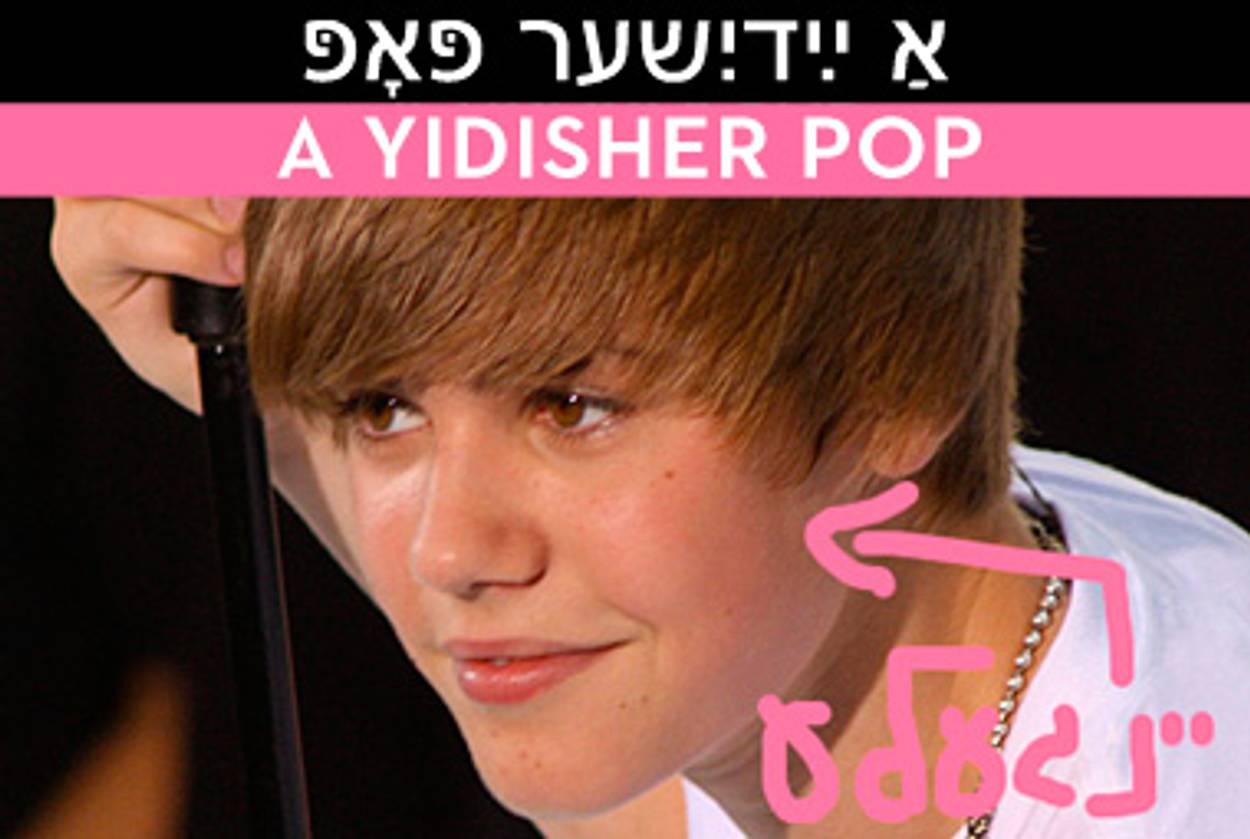A Yidisher Pop
Justin Bieber, Angelina Jolie, and a lesson in Yiddish




Missed our earlier installments? Click here for the “A Yidisher Pop” homepage.
This week’s installment is about curse words, countdowns, and criminal behavior. Let’s get right to it:
חנעוודיק ווען ער איז אין טעלעוויזיע, אוּן ברוּטאַל אין פּריוואַטן לעבן. אין 36 שעה ווערט ער אַ מענטש? אַן אַקטיאָר!
Transliteration: Kheynevdik ven er iz in televizye, un brutal in privatn lebn. In 36 sho vert er a mentsh? An aktyor!
Meaning: Charming on TV, and brutal in private life. He’ll become a mentsh in 36 hours? It’s an act!
[audio:https://www.tabletmag.com/wp-content/uploads/ayp/05/sounds/sheen.mp3]
דאָס איז יידיש? אַרויסגעוואָרפֿן דעם הוּמאָר אוּן געבליבן מיט אַ פּראָסטן וואָרט: אוי אַ שאַנדע, אַ שמוּץ, אַ בוּשה, אוּן אַ זילזוּל. שעמען מעג ער זיך.
Transliteration: Dos iz yidish? Aroysgevorfn dem humor un geblibn mit a prostn vort: oy a shande, a shmuts, a bushe, un a zilzul. Shemen meg er zikh.
Meaning: This is Yiddish? They left out the humor and kept the bad word: shameful, dirty, and disrespectful. Shame on you!
אַ בוּך — אַ מתנה פֿוּן אַנדרוּ מאָרטאָן פֿאַר אַנדשעלינקע. אַנדשי גיט אַ גרויסן נאָס, אַנדי כאַפּט אוּן זאָגט, אַ שאָס!
Transliteration: A bukh–a matone fun Andru Morton far Angelinke. Angie git a groysn nos, Andy khapt un zogt, a shos!
Meaning: A book — a gift from Andrew Morton to Angelin’ke. Angie sneezes, and Andy makes a fuss!
קויפֿערס וועלן זיך מחיה זייַן — אַ ביכעלע, 16 זייַטלעך מעשהלעך, וועגן אַ יינגעלע, אַ זינגערל, אוּן מיידעלעך אָן אַ סוף!
Transliteration: Koyfers veln zikh mekhaye zayn–a bikhele, 16 zaytelekh mayselekh, vegn a yingele, a zingerl, un meydelekh on a sof!
Meaning: Book buyers will have a field day — 16 little tales about the little boy, the little singer, and his endless stream of girls.
נאָך אַ חתונה! עס איז דאָ אַ חתן, אַ כלה, אוּן עס באַקט זיך אַ קינד. אַ מאָדע צוּ מאַכן אַ מוציא פֿאַר דער ברכה!
Transliteration: Nokh a khasene! Es iz do a khosn, a kale, un es bakt zikh a kind. A mode tsu makhn a moytse far der brokhe!
Meaning: Another wedding! A groom, a bride, and a baby in the oven. A new trend, having the meal before saying the blessing.
This week, it seems, was all about numbers, from Charlie’s rehab sentence to Justin Bieber’s book advance. The following numbers are used as nouns and adjectives in Yiddish:
איינס / איין — 1
צוויי — 2
דרייַ — 3
פֿיר — 4
פֿינף — 5
זעקס — 6
זיבן — 7
אַכט — 8
נייַן — 9
צען — 10
עלף — 11
צוועלף — 12
דרייַצן — 13
פֿערצן — 14
פֿוּפֿצן — 15
זעכצן — 16
זיבעצן — 17
אַכצן — 18
נייַנצן — 19
צוואַנציק — 20
The number one declines as a noun. For example, in relation to Steve Carell’s new film:
אויב איר נוּצט אַ יידיש וואָרט, גיט אוּנדז כאָטש איינס אַ רעכטן — If you’re going to use a Yiddish word, use a proper one
To pronounce compound numbers in Yiddish, just reverse the digits. Looking at Andrew Morton’s previous book, for example, a biography of Princess Diana, we can say:
מען האָט עס איבערגעזעצט אין נייַן אוּן צוואַנציק שפּראַכן — The book was translated into 29 languages
Or, looking at James Van Der Beek’s pregnant wife, we wonder how far along she may be:
וויפֿל וואָכן דאַרף זי נאָך טראָגן, פֿינף אוּוֹ דרייַסיק?— How many weeks, 35?
And Charlie Sheen, as we’ve learned this week, has time on his mind. Counting down his sentence, he may ask:
וויפֿל איז דער זייגער? — What time is it?
Last week, in observance of Chelsea Clinton’s wedding, we gave you no homework. This week, catching up, here are two assignments. First, read the captions once again, and find the different uses of the word נאָך, which means still, or after. Then, practice numbers by telling us how old you are. We’re looking forward to it…